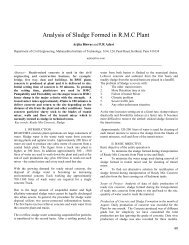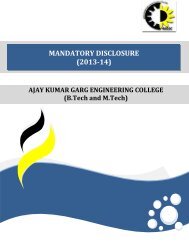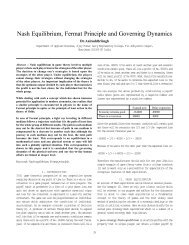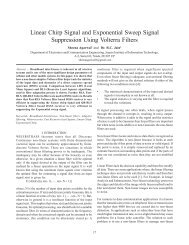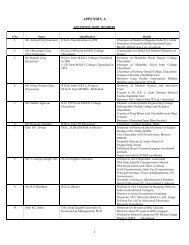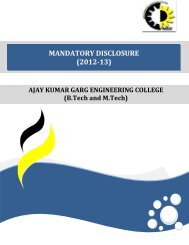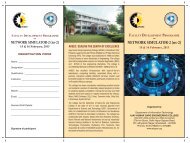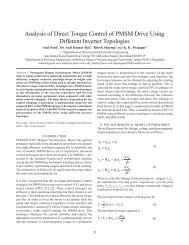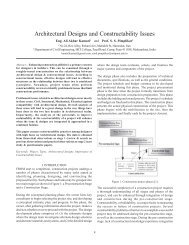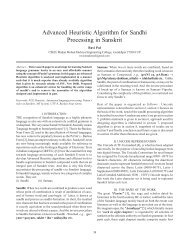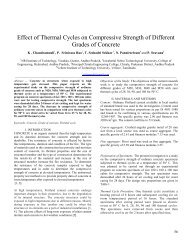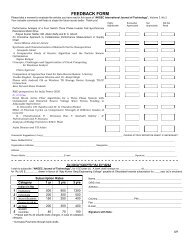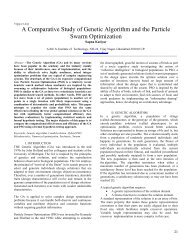Synthesis and Characterization of Bismuth Ferrite Nanoparticles
Synthesis and Characterization of Bismuth Ferrite Nanoparticles
Synthesis and Characterization of Bismuth Ferrite Nanoparticles
Create successful ePaper yourself
Turn your PDF publications into a flip-book with our unique Google optimized e-Paper software.
<strong>Synthesis</strong> <strong>and</strong> <strong>Characterization</strong> <strong>of</strong> <strong>Bismuth</strong> <strong>Ferrite</strong> <strong>Nanoparticles</strong><br />
Anoopshi Johari<br />
Department <strong>of</strong> Physics, National Institute <strong>of</strong> Technology, Kurukshetra 136119 Haryana<br />
anoopshi.akg@gmail.com<br />
OF ADAPTIVE VOLTERRA FILTERS<br />
__________________________________________________________________________________________________________<br />
.Abstract--In the present work, <strong>Nanoparticles</strong> (NPs) <strong>of</strong><br />
multiferroic bismuth ferrite (BiFeO 3 ) were synthesized via a wet<br />
chemical route using bismuth nitrate <strong>and</strong> iron nitrate as starting<br />
materials <strong>and</strong> excess citric acid as chelating agent, respectively,<br />
followed by thermal treatment at 350 ∘ C, 450 ∘ C <strong>and</strong> 550 ∘ C. It was<br />
found that BiFeO 3 nanoparticles crystallized at 350 ∘ C when<br />
using citric acid as chelating agent. BiFeO 3 nanoparticles with<br />
different sizes distributions show obvious ferromagnetic<br />
properties, <strong>and</strong> the magnetization is increased with reducing the<br />
particle size.<br />
The prepared samples were characterized by X-ray diffraction <strong>of</strong><br />
powder (XRD), scanning electron microscope (SEM) for<br />
extracting their surface morphology <strong>and</strong> their crystallographic<br />
structure. The surface morphology studies confirm the growth <strong>of</strong><br />
bismuth ferrite nanoparticles with their diameters in the range <strong>of</strong><br />
200nm to 500nm. The XRD analysis concludes the<br />
rhombocentered structure <strong>of</strong> synthesized nanoparticles.<br />
Keywords: <strong>Bismuth</strong> ferrite, <strong>Nanoparticles</strong>, X-ray diffraction<br />
I. INTRODUCTION<br />
BISMUTH <strong>Ferrite</strong> (BiFeO 3 , BFO) is one <strong>of</strong> the very few<br />
multiferroic materials with a simultaneous coexistence <strong>of</strong><br />
ferroelectric with high Curie temperature (T C = 810-830˚C)<br />
<strong>and</strong> anti-ferromagnetic order (below T N = 370˚C) parameters<br />
in perovskite structure. However, these two ordering<br />
parameters are mutually exclusive in principle because<br />
ferroelectricity <strong>and</strong> magnetism require different filling states<br />
<strong>of</strong> d shells <strong>of</strong> transition metal ions. Empty d shells mainly<br />
exist in ferro-electricity, while partially filled d shells are<br />
required in magnetism. Therefore multiferroic are rare <strong>and</strong> it<br />
exhibits weak magnetism at room temperature.<br />
Though BFO was discovered in 1960, recently there is a<br />
renewed interest because <strong>of</strong> its possible novel applications in<br />
the field <strong>of</strong> radio, television, microwave <strong>and</strong> satellite<br />
communications, audio-video <strong>and</strong> digital recording <strong>and</strong>, as<br />
permanent magnets. So far,<br />
bismuth ferrite powders have been prepared by the solid-state<br />
methods (classic [1, 2] <strong>and</strong> mechano-chemical ones [3] <strong>and</strong><br />
solution chemistry methods (such as precipitation/co<br />
precipitation [4], sol–gel [5, 6] hydrothermal [7] <strong>and</strong><br />
sonochemical [8] ones). Most <strong>of</strong> the mentioned procedures<br />
need high temperature treatments (>800°C). Due to the<br />
requirement <strong>of</strong> nanosized oxides <strong>and</strong> in order to avoid bismuth<br />
volatilization the developing <strong>of</strong> low temperature synthesis<br />
methods is essential [9]. Previous studies have demonstrated<br />
that synthesis <strong>of</strong> <strong>Bismuth</strong> <strong>Ferrite</strong>s nanoparticles through a<br />
traditional solid-state method produces poor reproducibility<br />
<strong>and</strong> causes formation <strong>of</strong> coarser powders as well as<br />
Bi 2 O 3 /Bi 2 Fe 4 O 9 impurity phase [7], [8]. Up to date, several<br />
chemical routes (for example: hydrothermal treatment,<br />
mechano-chemical synthesis method, <strong>and</strong> sol-gel<br />
methodology, etc.) have been successfully employed for<br />
fabricating BFO nanoparticles. However, these approaches<br />
have certain shortcomings such as impurities in the final<br />
products [9].<br />
In the present work, <strong>Bismuth</strong> ferrite (BiFeO 3 ) nanoparticles<br />
are successfully synthesized using citric acid. The sythesized<br />
bismuth ferrite (BiFeO 3 ) nano-particles were characterized by<br />
X-Ray Differaction (XRD) <strong>and</strong> Scanning Electron Microscope<br />
(SEM) for extracting their surface morphology <strong>and</strong> crystal<br />
structure.<br />
II. EXPERIMENTAL PROCEDURE<br />
In the present work, sol-gel method is used. For the synthesis<br />
<strong>of</strong> bismuth ferrite nano-particles, bismuth nitrate<br />
[Bi(NO 3 ) 3·5H 2 O] <strong>and</strong> iron nitrate [Fe(NO 3 ) 3 .9H 2 O] were<br />
weighed <strong>and</strong> dissolved in de-ionized water to make a solution<br />
<strong>of</strong> 0.2M. Afterwards some amount <strong>of</strong> diluted nitric acid (65%<br />
to 68% HNO 3 ) was added to the mixture. Then citric acid<br />
(C 6 H 8 O 7 ) was added to the solutions, this act as chelating<br />
agent.<br />
The light-yellow-colored solution was heated under vigorous<br />
stirring. The beaker with solid deposit was kept in the oven at<br />
150˚C. Powders were quarterly divided <strong>and</strong> calcinated in the<br />
oven at 350˚C, 450˚C, <strong>and</strong> 550˚C respectively, to obtain well<br />
crystallized <strong>Bismuth</strong> <strong>Ferrite</strong>s nano-particles with controllable<br />
sizes [10].<br />
After the complete chemical synthesis <strong>and</strong> heat treatment <strong>of</strong><br />
the synthesized products, the sample were characterized using<br />
X-ray diffraction (XRD) with a X-ray diffractometer with Cu<br />
Kα radiation (λ = 0.154178 nm) <strong>and</strong> Scanning Electron<br />
17
Microscope (SEM) for extracting their surface morphology<br />
<strong>and</strong> their crystallographic structure.<br />
Formation <strong>of</strong> precursor<br />
Figure 2: <strong>Bismuth</strong> <strong>Ferrite</strong>s nanoparticles calcinated at different<br />
temperature.<br />
<strong>Bismuth</strong> nitrate<br />
Solution<br />
Iron nitrate<br />
Solution<br />
20mL diluted<br />
Nitric acid<br />
Mixed solution<br />
Heating under vigorous stirring at 70˚<br />
C<br />
Citric acid<br />
91<br />
Fig. 1 Schematic for chelating complex formed by Citric acid, where<br />
purple st<strong>and</strong>s for Bi, blue for Fe, red for Oxygen <strong>and</strong> gray for Carbon<br />
atoms.<br />
Heating in the oven at 150˚C for 2 Hr<br />
Brown powder is obtained<br />
Calcined at 350˚C, 450˚C <strong>and</strong> 550˚C (<br />
calcination time = 2Hr)<br />
BiFeO 3<br />
Fig. 3 Process flow for the synthesis <strong>of</strong> <strong>Bismuth</strong> <strong>Ferrite</strong><br />
<strong>Nanoparticles</strong>.<br />
III. RESULTS AND DISCUSSION<br />
The synthesized bismuth ferrite nanoparticles were<br />
characterized by using the room temperature powder X-ray<br />
18
(012)<br />
(110)<br />
(113)<br />
(202)<br />
(024)<br />
(211)<br />
(122)<br />
(300)<br />
(125)<br />
(208)<br />
(220)<br />
(036)<br />
(312)<br />
diffraction with filtered 0.154 nm Cu Kα radiation for their<br />
phase analysis studies at different calcined temperatures <strong>of</strong><br />
350˚C, 450˚C <strong>and</strong> 550˚C. The calcined samples are scanned in<br />
a continuous mode from 20° – 80° with a scanning rate <strong>of</strong><br />
30/minute. The XRD analysis <strong>of</strong> BiFeO 3 (BFO) powder<br />
calcined at 350˚C,450˚C <strong>and</strong> 550˚C are shown in the Fig. 3.<br />
The prominent peaks in xrd plot are indexed to various hkl<br />
planes <strong>of</strong> BFO, indicating formation <strong>of</strong> BFO. Besides these<br />
prominent peaks, some other peaks <strong>of</strong> low intensity are also<br />
observed, which do not belong to BFO. The sample calcined<br />
at 550˚C is having many extra peaks other than BFO whereas<br />
that prepared at 350˚C is less impurity peaks. The literature<br />
survey <strong>of</strong> BFO synthesis relates these impurity peaks to be<br />
that <strong>of</strong> Bi 2 .88Fe5O 12 .<br />
(b)<br />
(c)<br />
Mag : 5K<br />
Mag : 10K<br />
The appearance <strong>of</strong> these extra phases at 550˚C could be due<br />
to large bismuth loss at higher temperature. Powder calcined<br />
at 450˚C is having less impurity phase <strong>of</strong> Bi 2 .88Fe5O 12 , as is<br />
evident from the lesser peak height than 550˚C.The<br />
synthesized bismuth ferrite nanoparticles were characterized<br />
by using the SEM for revealing their surface morphology at<br />
different calcined temperatures <strong>of</strong> 350˚C, 450˚C <strong>and</strong> 550˚C.<br />
The particle size estimated from SEM images for the BFO<br />
sample is about 200nm for the calcined temperature 350˚C,<br />
400nm for the calcined temperature <strong>of</strong> 450˚C <strong>and</strong> 500nm for<br />
the calcined temperature <strong>of</strong> 550˚C. The proportional increase<br />
in particle size is also confirmed by their surface morphology<br />
studies.<br />
(0<br />
12<br />
)<br />
)<br />
Fig. 4: SEM image <strong>of</strong> BiFeO 3 nanoparticles synthesized at calcination<br />
temperature <strong>of</strong> (a) 350˚C (b) 450˚C (c) 550˚C<br />
IV. CONCLUSION<br />
In the reported experiment, bismuth ferrite (BiFeO 3 )<br />
nanoparticles are successfully synthesized by chemical route<br />
method using citric acid. The sythesized bismuth ferrite<br />
(BiFeO 3 ) nanoparticles were characterized by X-Ray<br />
Differaction (XRD) <strong>and</strong> Scanning Electron Microscope<br />
(SEM). The XRD characterization results indicates the<br />
rhombo centered structure <strong>of</strong> bismuth ferrite nanoparticles <strong>and</strong><br />
the SEM anaysis reveals that the diameter <strong>of</strong> bismuth ferrite<br />
(BiFeO 3 ) nanoparticles increases with calcination temperature<br />
<strong>and</strong> varies from 200 to 500nm by increasing the calcined<br />
temperature from 350˚C to 550˚C. This method avoids using<br />
traditional high temperature <strong>and</strong> therefore could be easily<br />
extended to other systems.<br />
V. ACKNOWLEDGEMENT<br />
Support from IIT Delhi <strong>and</strong> NIT Kurukshetra for SEM <strong>and</strong><br />
XRD characterization is gratefully acknowledged.<br />
Fig 3: XRD patterns <strong>of</strong> BiFeO 3 nanopaticles synthesized at 350˚C, 450˚C <strong>and</strong><br />
550 ˚C.<br />
(a)<br />
Mag : 10K<br />
VI. REFERENCES<br />
[1] W. Eerenstein, N. D. Mathur, <strong>and</strong> J. F. Scott, ‘‘Multiferroic <strong>and</strong><br />
Magnetoelectric Materials,’’ Nature, 442 [7104] 759–65 (2006).<br />
[2] G. Catalan <strong>and</strong> J. Scott, ‘‘Physics <strong>and</strong> Applications <strong>of</strong> <strong>Bismuth</strong><br />
<strong>Ferrite</strong>,’’ Adv.Mater., 21 [24] 2463–85 (2009).<br />
[3] P. Fischer, M. Polomska, I. Sosnowska, <strong>and</strong> M. Szymanski,<br />
‘‘Temperature Dependence <strong>of</strong> the Crystal <strong>and</strong>Magnetic Structures <strong>of</strong><br />
BiFeO3,’’ J. Phys. C, 13 [10]1931–40 (1980).<br />
[4] S. M. Selbach, T. Tybell, M. A. Einarsrud, <strong>and</strong> T. Gr<strong>and</strong>e, ‘‘Size-<br />
Dependent Properties <strong>of</strong> Multiferroic BiFeO3 <strong>Nanoparticles</strong>,’’ Chem. Mater.,<br />
19 [26] 6478–84(2007).<br />
19
AKGEC INTERNATIONAL JOURNAL OF TECHNOLOGY, Vol. 2, No. 2<br />
[5] W. Eerenstein, N. D. Mathur, <strong>and</strong> J. F. Scott, “Multiferroic <strong>and</strong><br />
magnetoelectric materials,”Nature, vol. 442, no. 7104, pp. 759–765.<br />
[6] P. Fischer, M. Polomska, I. Sosnowska, <strong>and</strong> M. Szymanski, “Temperature<br />
dependence <strong>of</strong> the crystal <strong>and</strong> magnetic structures <strong>of</strong> BiFeO3,” Journal <strong>of</strong><br />
Physics C, vol. 13, no. 10, pp. 1931–1940, 1980.<br />
[7] C. Tabares-Munoz, J. P. Rivera, A. Monnier, <strong>and</strong> H. Schmid,<br />
“Measurement <strong>of</strong> the quadratic magnetoelectric effect on single crystalline<br />
BiFeO3,” Japanese Journal <strong>of</strong> Applied Physics, vol. 24, pp. 1051–1053, 1985.<br />
[8] Y. P. Wang, L. Zhou, M. F. Zhang, X. Y. Chen, J.-M. Liu, <strong>and</strong> Z. G. Liu,<br />
“Room-temperature saturated ferroelectric polarization in<br />
BiFeO3 ceramicssynthesized by rapid liquid phase sintering,” Applied<br />
Physics Letters, vol. 84, no. 10, pp. 1731–1733.<br />
[9] M. Fiebig, T. H. Lottermoser, D. Fröhlich, A. V. Goltsev, <strong>and</strong> R. V.<br />
Pisarev, “Observation <strong>of</strong> coupled magnetic <strong>and</strong> electric domains,” Nature,<br />
vol. 419, no. 6909, pp. 818–820, 2002.<br />
[10] Y. P. Wang, L. Zhou, M. F. Zhang, X. Y. Chen, J.-M. Liu, <strong>and</strong><br />
Z. G. Liu, “Room-temperature saturated ferroelectric polarization in<br />
BiFeO3 ceramics synthesized by rapid liquid phase sintering,”<br />
Applied Physics Letters, vol. 84, no. 10, pp, 1731–1733, 2004.<br />
Anoopshi Johari is currently an<br />
Assistant Pr<strong>of</strong>essor in Kumaun<br />
Engineering College, Dwarahat,<br />
Almora) . Did M.Tech in<br />
Nanotechnology from National<br />
Institute <strong>of</strong> Technology,<br />
Kurukshetra in 2011 <strong>and</strong> BTech in<br />
ECE from Ajay Kumar Garg<br />
Engineering College, Ghaziabad in<br />
2009.<br />
Did six months research work on<br />
Tin Oxide Nanowires <strong>and</strong> two<br />
months summer project at I.I.T.<br />
Delhi in the field <strong>of</strong> Multi ferrites.<br />
Published a paper in International Journal <strong>of</strong> Applied Engineering Research.<br />
Attended National Conferences <strong>and</strong> International Workshop.<br />
Folio<br />
BISMUTH FERRITE NANOPARTICLES<br />
20



